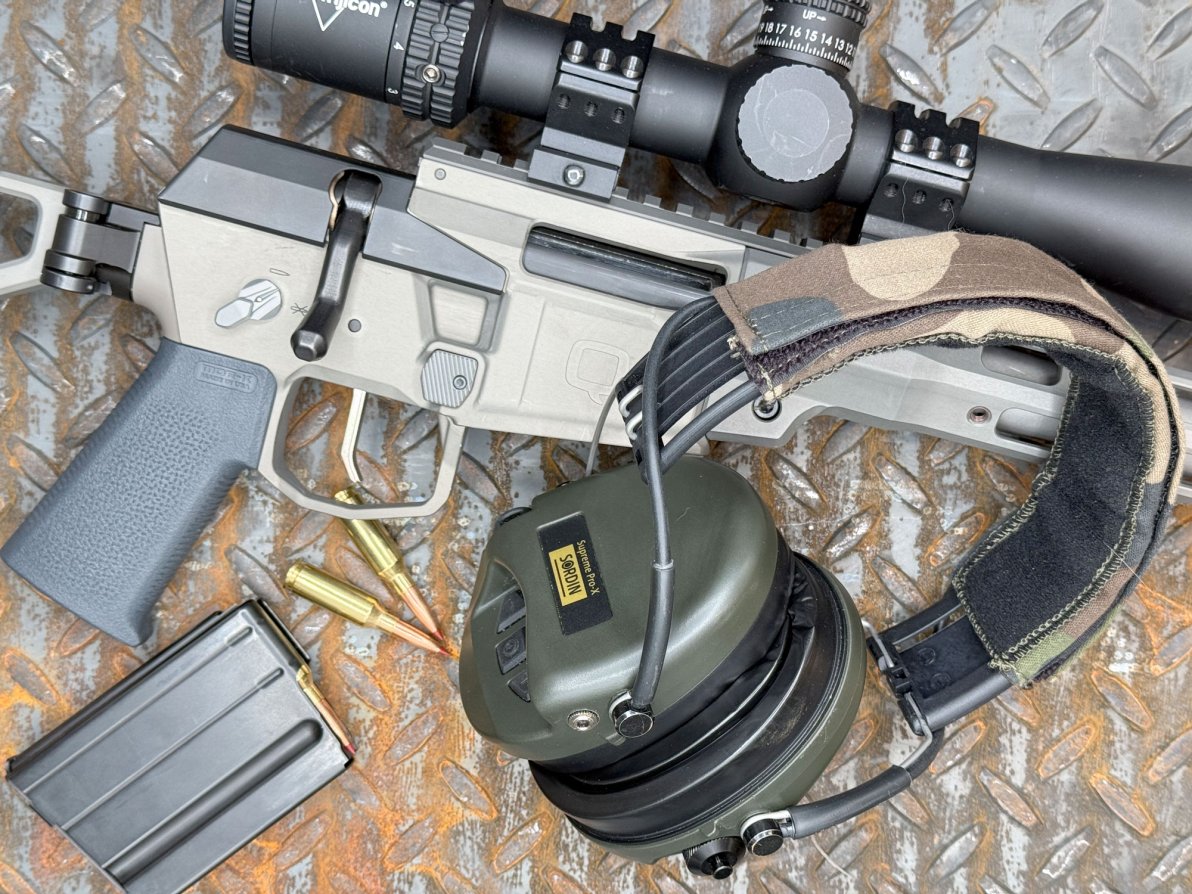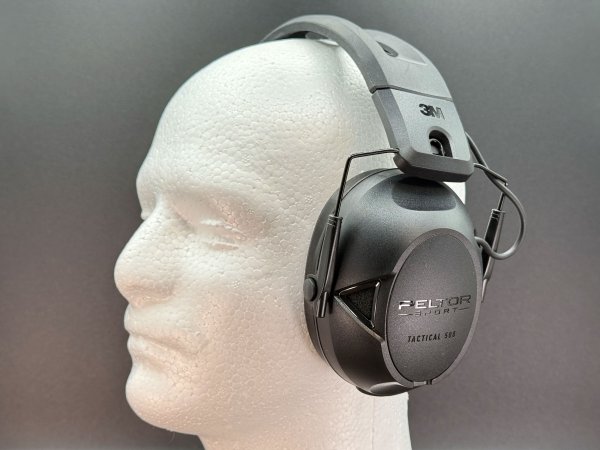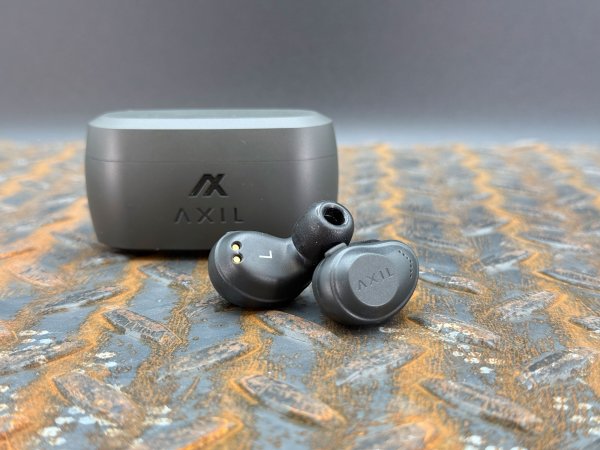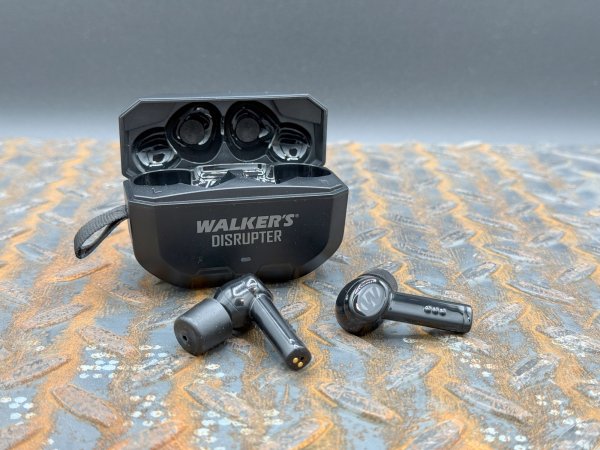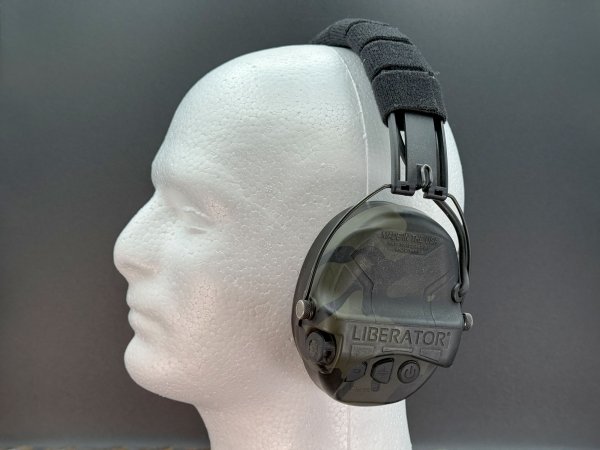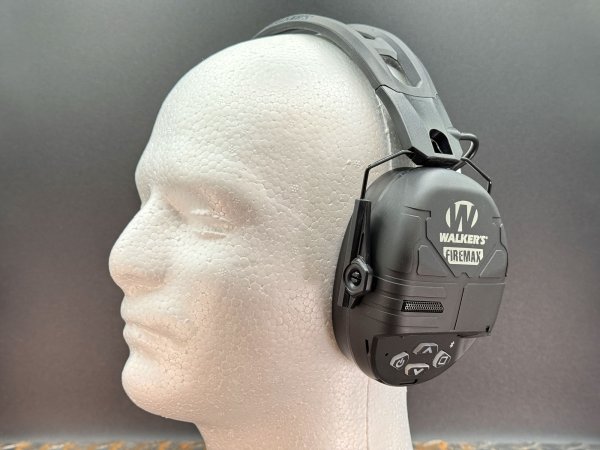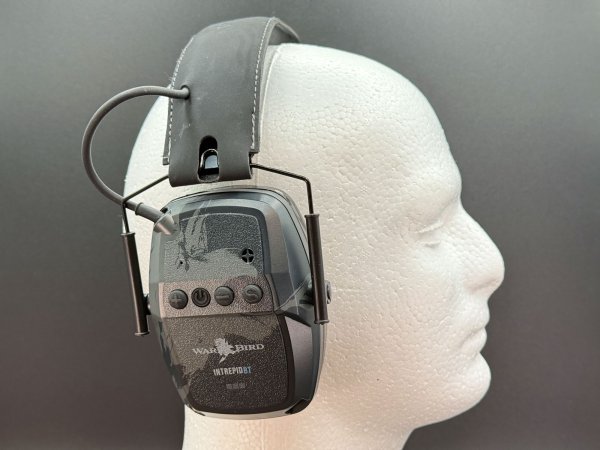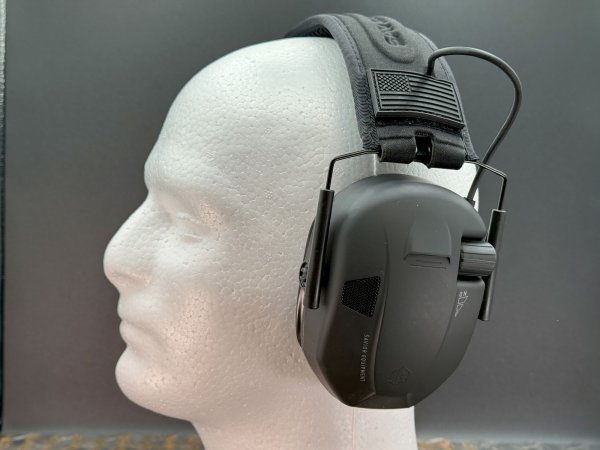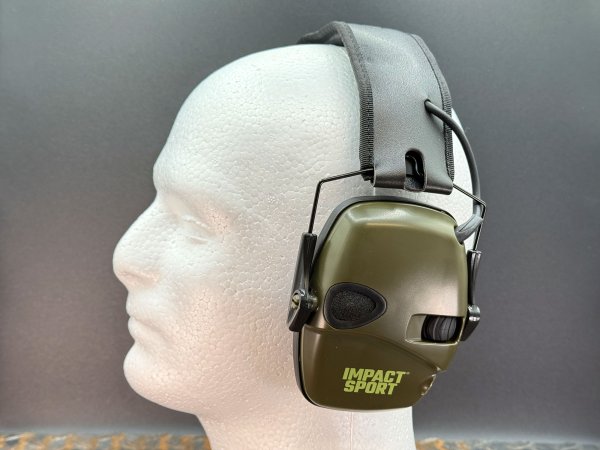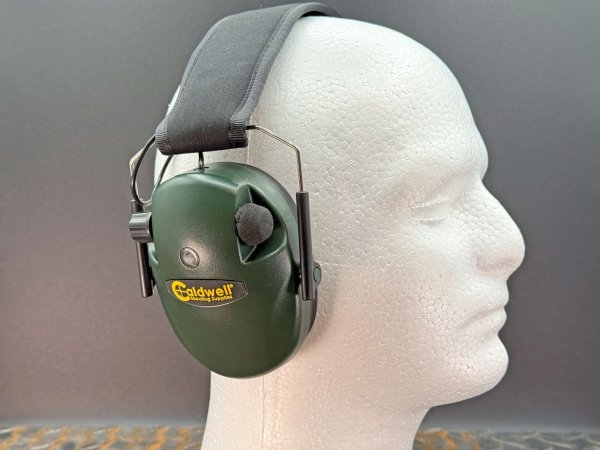We may earn revenue from the products available on this page and participate in affiliate programs. Learn More ›
There’s no excuse for damaging your hearing when you’ve got the best electronic hearing protection at your fingertips. Electronic hearing protection offers shooters the benefit of sound mitigation while providing amplification of non-harmful sounds. This can help you communicate more easily and be more aware of your surroundings — an important benefit for both shooting and working applications. Whether you’re older and trying to preserve the hearing you have, or you’re set on doing things right in the first place, this guide will help you pick the best electronic hearing protection for you.
- Best Overall: Sordin Supreme Pro-X
- Best Bluetooth: Peltor Sport Tactical 500
- Best In-Ear: Axil XCOR Pro
- Best Value: Walkers Razor Slim
More In-Ear Electronic Hearing Protection:
More Over-Ear Electronic Hearing Protection:
- Safariland Liberator HP 2.0
- Walker’s Firemax Bluetooth Digital Muffs
- Warbird Intrepid BT
- Savior Equipment Apollo
- Shellshock Exo Pro
- Howard Leight Impact Sport
- Caldwell E-max
How We Test the Best Electronic Hearing Protection
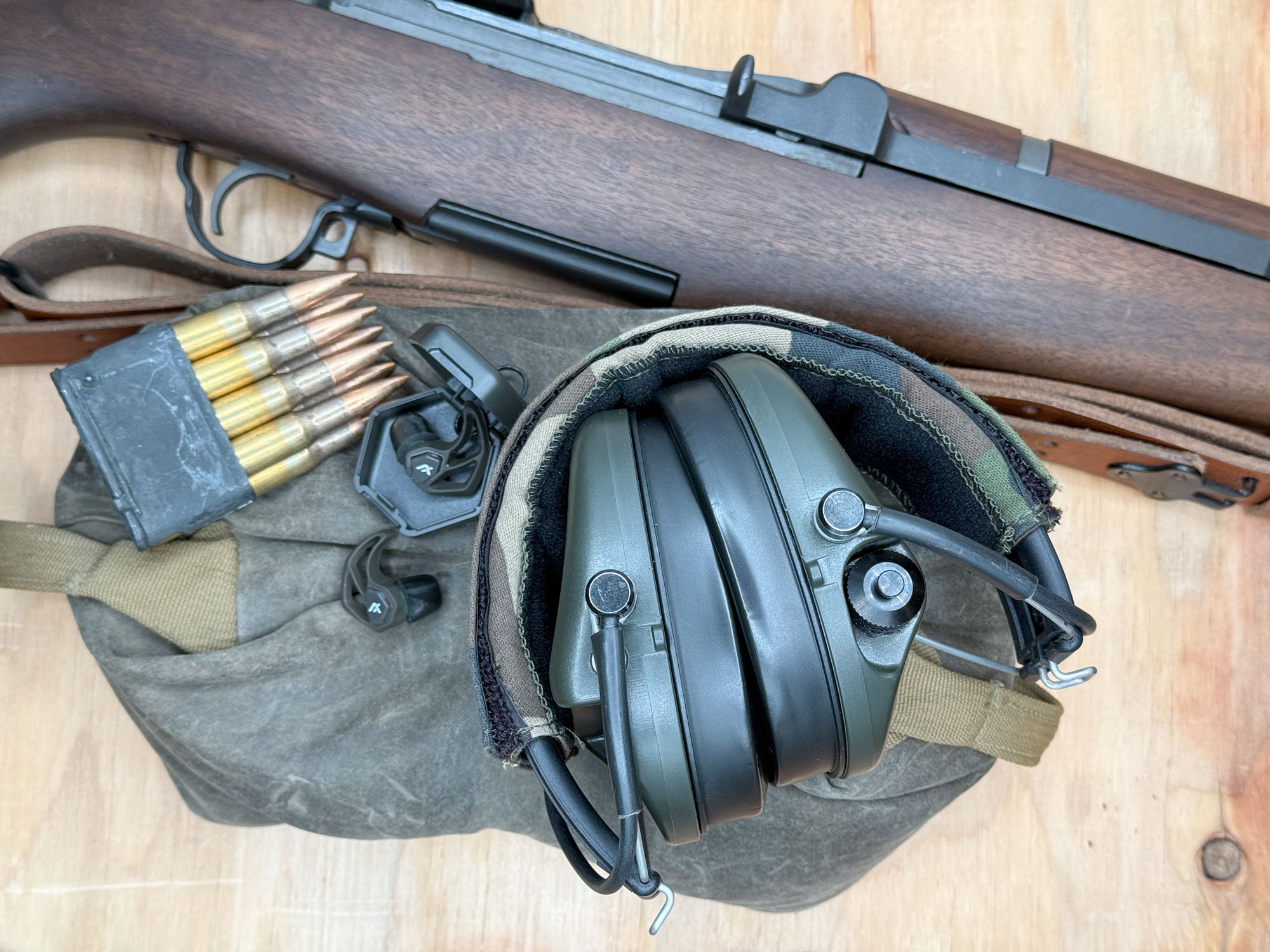
We take our product recommendations and evaluations seriously at Outdoor Life, and we don’t recommend stuff we haven’t used. To evaluate this field of electronic hearing protection, we put each set through a variety of use cases, paying attention to both its perceived sound-dampening effectiveness and its practical functionality. We use it while shooting both rifles and handguns, indoors and outdoors, suppressed and unsuppressed, and while shooting with muzzle brakes.
Each unit was tested in warm and cold temperatures, while wearing different styles of hats, glasses, and other gear. We evaluate each set of ear pro on fit, comfort, user friendliness of controls, and perceived sound reduction. For bluetooth-equipped hearing protection, we test functionality, and sound quality as well.
Best Electronic Hearing Protection: Reviews and Recommendations
Best Overall: Sordin Supreme Pro-X
Pros
- Slim ear cups
- Comfortable for long periods of time
- Compatible with radio comms
- Excellent battery life
Cons
- Headband has small range of adjustability
- Battery removal can be challenging
Key Features
- Noise Reduction Rating (NRR): 21 Decibels
- Batteries: two AAA batteries
- Removable overhead plastic band with cloth wrap, can be used with a helmet
- Knurled battery compartment cap
- Wind-resistant microphones
- Replaceable gel cups
- Price: $308
Description:
Sordin makes some of the best electronic hearing protection on the market, and the Supreme Pro-X is a great option for anyone who wants the best in performance, comfort, durability, and versatility. This ear pro is made in Sweden and comes with a five-year warranty. It has slim ear cups that don’t interfere with your rifle stock, and is powered by two AAA batteries. There is a knurled cap on the battery compartment and, aside from a small diagram on a sticker, battery orientation isn’t that intuitive. Also, removing the second battery can be a challenge. The good news is that they offer excellent battery life. Sordin claims 400 hours on the two tiny batteries. I’ve been using them for several months in 0- to 30-degree temperatures, and have yet to exhaust the batteries that came with the unit.
Despite that, this is an excellent set of ear pro. The gel cups are comfortable to wear for long periods of time and replaceable if they get damaged. The Supreme Pro-X has a foam-covered microphone on each ear and provides good-quality sound. Sound levels and power can be toggled on the left-side keypad, which can also toggle between different modes for varying levels of background noise. Like other quality sets of ear pro, these provide enhanced sound, but cut out loud impulse noises. The microphones don’t get too noisy in windy conditions, but they tend to squeak when putting on or removing the ear muffs while powered up. Through extensive indoor and outdoor use, we have found a lot to like about the Sordin Supreme Pro-X, and very little to dislike.
Best Bluetooth: Peltor Sport Tactical 500
Pros
- Excellent fit and sound suppression
- Large, intuitive control buttons
- Rechargeable battery
- Low wind noise
Cons
- Ear cups aren’t very slender
Key Features
- Noise Reduction Rating (NRR): 26 Decibels
- Batteries: Rechargeable, USB mini
- Large bluetooth and volume control buttons
- Protected speakers not too noisy in the wind
- Wide headband with cutout for ball cap top button
- Textured ear cups
- Price: $139
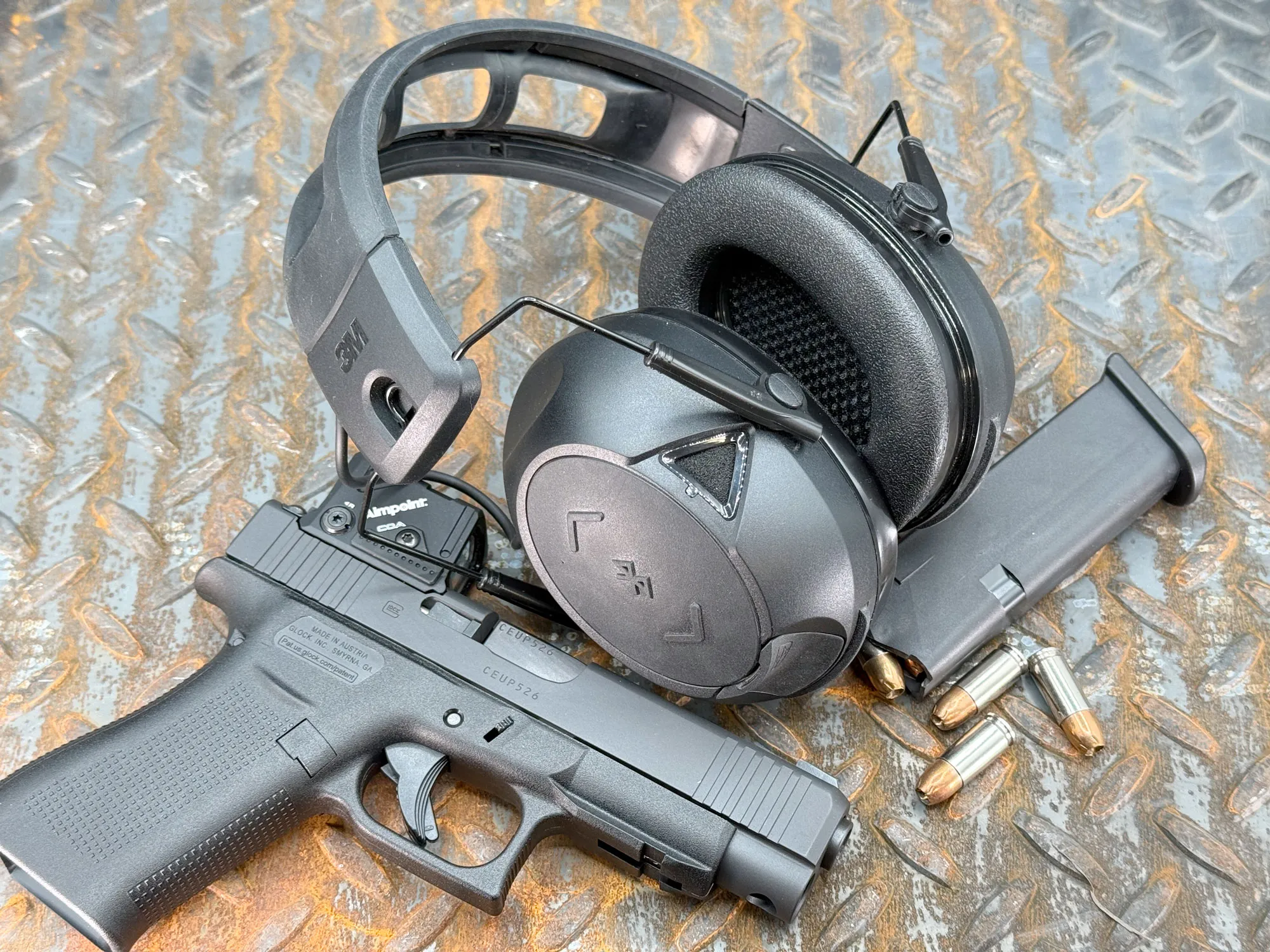
Description:
Peltor has long been a leader in electronic hearing protection, and produced some of the first widely-available models that would cut out impulse noise. I remember getting my first set over 20 years ago. The fully modern Tactical 500 bluetooth hearing protection is an excellent choice for any shooting or loud noise application. This set of ear muffs has heavy-duty ear cups with textured padding that provide a fantastic seal. On top, they have a wide rubber head band that has cutouts — including one that’s designed to sit comfortably on top of a ball cap.
The Tactical 500 ear muffs are rechargeable via a USB micro port on the bottom of the right side, next to an audio jack that can be used with a radio. The bluetooth and volume control buttons are on the right side also, and oversized to make operation easy, even with gloves. Bluetooth pairing is simple and easy. I like that the power button is small and somewhat sunken into the rear of the right side, protecting it from accidental power on/off. The microphones are similarly sunken and well-protected and, combined with their foam covers, really cuts down on wind static.
Best In-Ear: Axil XCOR Pro
Pros
- Secure, low-profile fit
- Can be used independently with two devices
- User-friendly controls
- Foam and rubber ear tips
Cons
- Expensive
- Foam tips rebound quickly when compressed
Key Features
- Noise Reduction Rating (NRR): 23 Decibels
- Batteries: Recharges in case, USB-C
- Function controls on left and right bud
- Hard-sized carrying case for charging case, cord, and extra tips
- Can be used for calls, and individual earbuds can be paired to different phones
- Price: $199
Description:
The best in-ear electronic hearing protection is subtle, comfortable, doesn’t interfere with your cheek weld, and still offers plenty of protection. The best that I’ve found is the XCOR Pro from Axil. This set of in-ear buds is similar to air pods, but provides excellent sound protection and a low-profile fit. XCOR Pro earbuds come with a rechargeable flip top magnetic carry case that pulls the buds firmly down onto the charging leads when you drop them in. The case is rechargeable via an included USB-C cord and provides approximately three full charges to the earbuds. They should last between 5 and 13 hours depending on mode. You also get a hard-sided zippered carry case that contains rubber and foam ear tips and can keep everything together.

The XCOR Pro needs to be fit correctly but, when they are, they have a very low profile that allows muffs to be worn comfortably over the top. To fit them correctly, pinch down the foam earplug tips and quickly insert them into your ear canal. Then twist the plug until the large end of the teardrop-shaped electronic is pointed rearward and nestled into the concha or bowl of your ear. As the foam plugs expand, they should seal completely in your ear. This is very valuable if you’re shooting indoors or around muzzle brakes. These earbuds have good sound and can be used with the rubber ear tips for general use purposes. The foam tips are to be used for shooting. They work well but the foam is pretty springy and you must put them in your ear quickly after pinching them for a good fit.
Overall, these offer some of the best quality for sound, noise suppression, and user friendliness. These would be great for an everyday-use earbud that’s also used for shooting or working in loud environtments. Like other electronic hearing protection, these can be set to mute or to amplify non-harmful ambient sounds for clear communication.
Best Value: Walker’s Razor Slim
Pros
- Best-in-class value
- Durable
- Simple control wheel
- Variety of colors and patterns
- Very affordable
Cons
- Lots of wind noise feedback
Key Features
- Noise Reduction Rating (NRR): 23 Decibels
- Batteries: two AAA batteries
- Wide padded headband
- Available in 22 colors and patterns
- Rolling on/off and volume switch
- Audio jack compatible with radio attachment
- Price: $34
Description:

In recent years, Walkers Razor Slim earmuffs have been one of the most popular sets of electronic hearing protection on the market. I have a couple pairs of these that have been getting used hard for three or four years with no signs of stopping. The Razors are a slim-fitting ear muff with a good-quality padded headstrap, which fold up into a compact size when not in use. They don’t have a lot of bells and whistles, but feature a single rolling on/off and volume control knob. Powering on turns on the internal speakers which magnify ambient sounds but cut out loud impulse noises like gunshots. One handy feature is an audio jack. The Razors can be used in conjunction with a hands-free walkie talkie clip-on unit from Walkers for another $30.
When shooting indoors or with brakes, I always double up with ear plugs, but for most general shooting, they do a great job. The Razors aren’t as comfortable as units with gel cups, but they are more durable. These used to cost $80 to $100, but have come down dramatically in price. If you’re looking for an affordable set of quality electronic hearing protection, look no further.
Isotunes Sport Caliber BT
Pros
- Compact and light
- Large control surface
- Charges in carry case
- Useful for more than just shooting
Cons
- Foam tips rebound too quickly
Key Features
- Noise Reduction Rating (NRR): 25 Decibels
- Batteries: Rechargeable via carrying case, USB-C
- Power, volume, and track controls
- Includes foam ear plug adapters
- Can be used for calling with smartphone
- Price: $180
Description:
The Caliber BT is another great option for shooters who want an in-ear set of bluetooth hearing protection. They come in a small hard carry case with a flip-open top and battery life indicator. The earbuds charge in their carry case and the charging prong location and magnets help ensure that they charge reliably. The case itself is charged with a USB-C cord, just like many non-shooting types of earbuds. The Caliber BT buds have a large control surface that’s easy to use, and their quick-start guide shows how to operate them — the surfaces are smooth and some functions are controlled with the left side, others on the right.
These earbuds provide good sound protection, but are on the light side for shooting indoors or around muzzle brakes. The only significant downside was that the foam earplug tips that the Caliber BT comes with rebound too quickly. That means that after you squeeze them down — as you would with any standard set of foam earplugs — they bounce back to their original size before you can get them fully in your ear. Because of this, it’s tough to get an ideal seal and the best possible sound protection.
Walker’s Disruptor Earbuds
Pros
- Compact and versatile
- Rechargeable in case
- Sound suppression or normal earbud function
- Multiple sizes of foam and rubber ear tips
Cons
- Earbuds can be finicky about charging
Key Features
- Noise Reduction Rating (NRR): 26 Decibels
- Batteries: Rechargeable via carrying case, USB-C
- Power, volume, and mode controls
- Includes foam ear plug adapters and regular rubber earbud tips
- Can be used for calling with smartphone
- Price: $250
Description:
Some of the best in-ear electronic hearing protection plugs are the Walker’s Disruptor earbuds. This pair features a small body, which accepts both foam earplug-style tips and the included normal earbud-style rubber tips. They can be used as shooting ear pro, general use for loud environments, or as your everyday ear bud for music or hands-free calls. Each side has a stem that acts as a control surface to turn on, adjust volume, answer calls, and change modes.
The Disruptors can operate in mute mode or allow passthrough of ambient noise for better situational awareness. These earbuds cut out impulse noise and do a good job of taming down gunshots. The foam eartips are nice and stiff and don’t rebound too quickly. For me, they are great for suppressed shooting and OK for outdoor handgun and rifle applications, but I need a little bit better protection for shooting with brakes or indoor shooting. The only trouble I had with the Disruptors is that they seemed to be finicky about charging. If I didn’t carefully ensure each bud plugged into the case, one side would have a low battery the next time I removed them from the case. They are magnetized like other ear buds, but the charging leads are on the end of the stem and I suspect they don’t always get the best connection.
Safariland Liberator HP 2.0
Pros
- Slim ear cups
- Good quality sound and directional awareness
- User-friendly intuitive controls
- Comfortable for long periods of time
- Rechargeable battery
Cons
- Expensive
- Sound protection isn’t great for muzzle breaks or indoor shooting
Key Features
- Noise Reduction Rating (NRR): 26 Decibels
- Batteries: USB-C rechargeable (different battery options available)
- Removable headband, unit can be used with a helmet
- Available in different color and patterns
- Wind-resistant microphones
- Replaceable gel cups
- Price: $370
Description:
Safariland’s Liberator HP 2.0 electronic hearing protection is one of the most comfortable and intuitive units that we have tested. It’s designed to be used in a variety of applications and can be configured to use with a helmet — a handy perk for those using night vision. The Liberator ear pro has low-profile ear cups that are thinnest at the top, and the replaceable gel cup padding makes you forget that they’re even on your head. They’ve got large, intuitive control buttons, with which you can toggle between different ambient sound modes and adjust the internal speaker volume. The external mics are covered with a layer of foam and protected by a small rubber cage. They offer good directional sound awareness but, like any other electronic hearing protection, sound direction isn’t perfect.
I’ve been using my pair for nearly a year, and it’s my go-to for outdoor handgun shooting or shooting suppressed rifles. Despite the relatively high NRR of 26 decibels, I’ve found the sound dampening to be inadequate for shooting or being around unsuppressed rifles or shooting indoors without doubling up with internal plugs. It’s always a good idea to double up with plugs and over-ear electronic hearing protection when shooting indoors, under cover, or near muzzle brakes. But if you don’t do so while using the Liberators, sounds are still painful — an indication that sound levels are significantly above dangerous levels. It’s a bit disappointing, but for most applications, this is still an excellent set of ear pro.
Walker’s Firemax Bluetooth Digital Muffs
Pros
- Rechargeable
- Split headband for ball caps
- Simple controls
- Replaceable gel cups
Cons
- More wind noise than some other models
Key Features
- Noise Reduction Rating (NRR): 21 Decibels
- Batteries: Rechargeable (USB-C)
- Four control buttons
- Audio jack and USB pair with Walker’s Walkie-Talkie attachment
- Split headband with texture pads
- Gel ear cups
- Price: $144
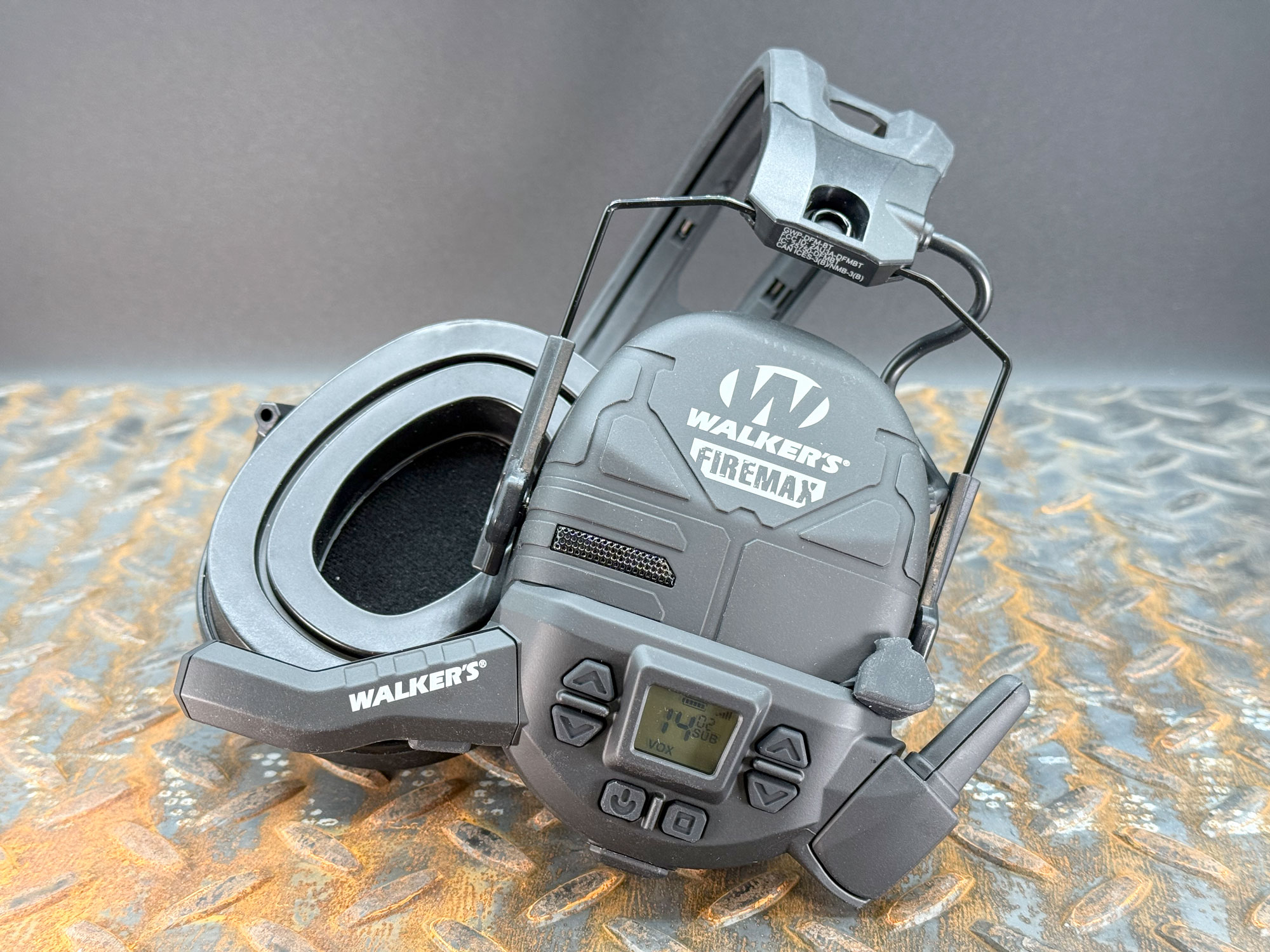
Description:
Walker’s Firemax are some of the best bluetooth hearing protection over-ear muffs that you can get for the money. These heavy-duty ear muffs have medium-slim cups which include removable gel-cup inserts. The Gel cups help provide a really good seal and are comfortable to wear for long periods of time. The Firemax has a wide split headband, which is really nice for wearing on top of a ball cap — the headband straddles the button rather than pushing down on it. The sides of the headband have rubberized textured grip pads to hold the ear cups in place firmly.
This unit has simple, user-friendly control buttons for power, bluetooth, mode, and volume, and the slender microphone cuts are covered with perforated metal. Wind noise isn’t bad, but it’s not as quiet as some other models. The Firemax bluetooth muffs are also made to pair with the Walker’s Firemax Walkie Talkie attachment, which clips directly onto the left ear muff and plugs right into the on-board audio jack. The unit has a rechargeable battery that uses a USB-C cord and is great for a variety of shooting applications.
Warbird Intrepid BT
Pros
- Slim ear cups
- Easy pairing and mode toggling
- Comfortable gel cups
- Can mute or amplify ambient noise
Cons
- Moderate wind noise
- Controls could be more intuitive
Key Features
- Noise Reduction Rating (NRR): 23 Decibels
- Batteries: Mini-USB rechargeable
- Power, volume, and mode buttons
- Bluetooth activation and pairing button
- Leather-like padded head band
- Gel ear cups
- Price: $159
Description:
The Intrepid BT from Warbird is a slim-fitting set of over-ear bluetooth hearing protection with an on-board battery that’s recharged via a USB mini jack. It has a solid cushioned headband with leather-like texture, and an audio jack for linking up radio comms. The Intrepid has good sound and the speakers provide pretty good spatial awareness — though like similar microphone designs, they do create some feedback in the wind.
The controls on the Warbird ear pro are pretty simple, but buttons are a bit small and everything could be a little bit more intuitive. Still, pairing with your phone is simple, and once you’re used to the configuration, operation isn’t difficult. A nice feature is that you can switch between modes that mute or allow ambient sounds while connected to bluetooth, or turn bluetooth off entirely.
Savior Equipment Apollo
Pros
- Great value
- Comfortable
- Intuitive controls
- Available in a variety of colors
Cons
- Ear cups are a bit thick
- Metal protective grate over microphones is noisy in the wind
Key Features
- Noise Reduction Rating (NRR): 23 Decibels
- Batteries: two AAA batteries
- Wide mesh headband with hook-and-loop name and flag patches
- Available in 12 colors
- Rolling on/off and volume switch
- Gel cups
- Price: $39
Description:
The Savior Equipment Apollo electronic hearing protection is one of the best options for the money. They have a large mesh-lined headband for comfort, and feature gel cups for a sound-dampening seal. Gel cups are comfortable in a variety of conditions and, even when sweaty, provide a good deal to keep harmful noise out. A downside is that, unlike some of the top-end electronic hearing protection, these gel cups aren’t a universally interchangeable design.
The Apollo ear muffs aren’t especially slim, but they have well-protected microphones and a rolling toggle switch that turns the unit on and controls volume. They’re powered by two AA batteries installed beneath a removable cover on the right side. The headband comes with hook-and-loop and rubberized removable patches — one of which is intended to be a name tag. There isn’t an obvious gap between the Savior Apollo and some more expensive sets of ear pro. The metal-covered microphones do make some noise in the wind, and you could be careful when installing or removing the battery cover. But I had no issues with their noise protection, even when shooting my 20-inch .300 PRC equipped with a side-baffle muzzle brake. For less than $40, these are hard to beat.
Shellshock Exo Pro
Pros
- Affordable
- Easy pairing
- Wide sizing adjustment range
- Independent ambient and bluetooth volume adjustment
Cons
- Lots of wind noise
- Service life won’t be as long as high-end ear pro
Key Features
- Noise Reduction Rating (NRR): 21 Decibels
- Batteries: two AAA batteries
- Independent ambient sound and bluetooth volume knobs
- Bluetooth activation and pairing button
- Wide headband with good adjustment range
- Gel ear cups
- Price: $100
Description:
I appreciate that there is a lot of adjustment range in the wire connections to the headband — something that is helpful when wearing a beanie or other hats. Sound dampening is good and, like other electronic hearing protection, speakers cut out to mitigate loud impulse noises. One downside is that while the microphones, which are embedded in the ear cups and exposed through a small grate, are well protected, the design causes a lot of noise and feedback in windy conditions. Also, it’s notable that these appear to be exactly the same unit as the Axil Trackr Blu. These are a good buy for a hundred bucks but, based on design and component quality, don’t expect the same service life as some of the more expensive sets.
The Exo Pro from Shellshock is a good example of quality bluetooth hearing protection that’s still affordable. These over-ear muffs run on two AA batteries that are easily replaceable via a removable cover on the right side. The lower half of the ear muff is slimmed down to reduce interference with rifle butt stocks, and the gel cups help facilitate a comfortable fit — though these gel cups do feel a bit more rigid than on high-end ear pro. Controls are very simple and intuitive. A simple rolling switch turns the unit on and adjusts volume of the ambient sound, while a small gear knob next to it adjusts bluetooth volume. This is a really easy unit to set up and use, and the bluetooth button turns bluetooth on and, when using for the first time, is used to set up pairing mode.
Howard Leight Impact Sport
Pros
- Affordable
- Really slim ear cups
- Radio comms compatible
- Not much wind noise
Cons
- Ear cups are stiff
- Control wheel isn’t the most intuitive
Key Features
- Noise Reduction Rating (NRR): 22 Decibels
- Batteries: two AAA batteries
- Wide padded leather-like headband
- Available in nine colors and patterns
- Rolling on/off and volume switch
- Audio jack compatible with radio
- Price: $70
Description:
The Impact Sport electronic hearing protection from Howard Leight is an affordable and really slim set of ear muffs. The ear cups themselves are plastic and about as thin as they can realistically be. The ear cup pads are a little bit stiff, but they still provide a good seal and sound protection. This unit is powered by two AAA batteries and, like some others, has a single on/off/volume control toggle wheel. The wheel is simple to use but not as intuitive as others. Rather than roll the wheel upward or forward to turn the unit on and increase volume, you roll the switch horizontally backward to increase volume, and forward to decrease it and shut off the power.
For $50, this is a good set of ear pro, but there is lag in volume increase/decrease when you move the switch, and the speakers are subject to some electronic feedback noise — more than a lot of other units. Wind noises are pleasingly low, however, due to the foam-padded microphones, which are sunk into the ear cups and protected from potential breakage.
Caldwell E-Max
Pros
- Affordable
- Low-profile ear cups
- Comfortable
Cons
- Not a very durable design
Key Features
- Noise Reduction Rating (NRR): 23 Decibels
- Batteries: two AAA batteries
- Wide padded suede-textured headband
- Available in green or Mossy Oak Breakup
- Rolling on/off and volume switch
- Audio jack
- Price: $29
Description:
If you’re looking for budget-priced electronic hearing protection, the Caldwell E-Max might be the right choice for you. You can get a set for under $30, or a bit more if you want the Mossy Oak Breakup version. These ear muffs are powered by two AAA batteries and they have front-facing microphones to amplify ambient sounds while cutting out high-decibel sounds.
The E-Max muffs certainly have a budget look to them and I wouldn’t expect long-term viability to be great with hard use. Even in normal handling, I accidentally dislodged one of the microphones. The cords are thinner and materials generally seem cheaper than on many of the higher-end sets. That said, they are surprisingly comfortable and provide a great seal over the ears. The ear cups are slim, but some of the design features are a bit dated. The audio jack is located on top of the right muff and, though it’s compatible with most radio comms, it’s advertised on the box to be used with an iPod — which aren’t even made anymore. But these features don’t matter if you’re just looking for a cheap set of electronic ear pro. These will work just fine.
Things to Consider When Selecting Electronic Hearing Protection
To pick the best electronic hearing protection for your own use, there are some important things to understand and consider. The ultimate goal is to provide adequate protection to your ears, so you need to account for factors that can affect each unit’s performance while choosing a set that’s comfortable and works well for how you plan to use it.
Fit
The single most important factor in how well electronic hearing protection will work for you is fit. Ear pro generally comes labeled with a standardized Noise Reduction Rating (NRR), but hearing protection only works properly when it fits correctly. For over-ear muffs, you want ear cups that will comfortably fit over your ears and a headband that has the proper adjustment range. In-ear protection can be handy if you tend to wear stocking caps or other hats that can impede over-ear muffs, but you must select the proper sized ear tips.
User-Friendliness
Most electronic hearing protection is pretty simple, but some are better than others. Look for sets with intuitive control buttons and switches. You’ll want to be able to easily control volume and, with bluetooth models, device operation. For some people, especially shotgun shooters, a slimmer ear cup will work better, and not interfere with your gun stock. For handgun shooters, that might not matter so much. Rechargeable vs non-rechargeable is also something to consider for your convenience.

Price
Many of the best electronic hearing protection devices are pricey. You need to consider your own use case to determine what your budget should be. If you spend a lot of time shooting indoors, around muzzle brakes, or will spend a lot of time wearing it, it’s worth investing in a high-end set that will be comfortable and offer the best protection.
NRR Ratings
NRR ratings are on virtually every ear pro package and, generally, the higher the number, the better the protection offered. However, it does not directly represent the amount of sound suppression that you should expect to get. The NRR also assumes the device is fit properly. A realistic rating of actual decibel reduction requires you to subtract seven from the NRR rating. OSHA recommends dividing that figure by two, so a set of electronic hearing protection that has an NRR rating of 23 dB would have a real-world reduction of 8 dB. Importantly, just because a set has a relatively higher NRR rating, that doesn’t necessarily mean it will offer you more protection than a slightly lower-rated unit.
Double Up When Possible
If you are exposed to a high volume of shooting or loud noises, shoot indoors, or are around muzzle brakes, it’s wise to double up even the best electronic hearing protection with another layer. If you use passive ear pro like Surefire Sonic Defenders, Axil X30i, or regular foam ear plugs underneath electronic muffs, you can still hear amplified non-harmful sounds, but you also have increased protection. Most single-layer ear pro does not offer enough suppression to completely make those types of shooting ear safe. You can also use low-profile electronic ear buds underneath some sets of over-ear muffs for similar protection.
Read Next: Picking the Best Suppressor for Your Hunting Rifle
FAQ
There are many great options, but over-ear muffs like the Sordin Supreme Pro-X and in-ear buds like the Axil XCOR Pro are hard to beat.
Generally yes, an NRR rating of 23 is good enough for shooting, but the actual sound reduction you get will depend on how well your hearing protection fits and whether you use it correctly or not.
The military uses a wide variety of hearing protection, but commonly uses brands like Peltor and Sordin.
Final Thoughts
Hearing damage is permanent, and it’s cumulative. The best thing you can do is exercise an abundance of caution when shooting or being exposed to loud noises. Fortunately, the best electronic hearing protection is great at guarding your hearing while allowing you to converse and be aware of your surroundings. Pick something that fits your style and use applications, and take extra care to ensure proper fitting. When you can, double up with in-ear and over-ear hearing protection for best results.
